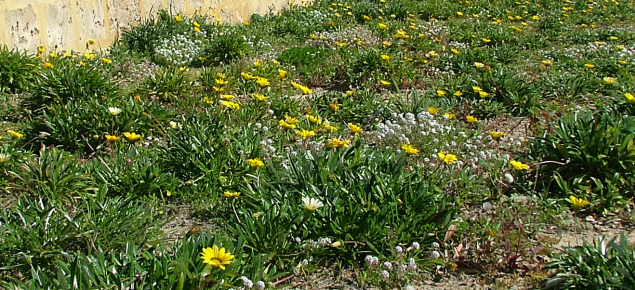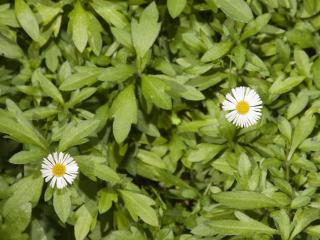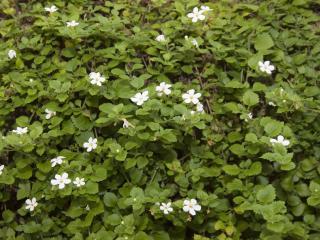Many groundcovers are prostrate perennials that form either a mat or multiple clumps, spreading by means of above-ground stolons or underground rhizomes. Some prostrate shrubs are also classed as groundcovers, and some climbers will grow vigorously across the ground if there is no vertical support for them to grow up.
Anticipating the spread
When buying a groundcover, read the label and take note of the height and width that it is expected to reach — then be prepared for it to exceed those dimensions, especially in optimum conditions. Be wary if the label describes a species as having “indefinite” spread. Avoid accepting cuttings from friends or neighbours who say that this particular plant gives rapid coverage. Do not order seeds from overseas, or seeds and plants from interstate, or the internet, as you might inadvertently bring in a weedy species that could pollute natural habitats in Western Australia.
Highly invasive groundcovers
Seaside daisy
Seaside daisy (Erigeron karvinskianis) — also known as shore daisy and wall daisy — not only spreads fast laterally but also works its way up into shrubs and can form smothering mounds.
Stems take root every few centimetres as they grow, and seeds germinate throughout the garden, including cracks in paths and driveways. If you want to grow it, do so in a clearly contained bed and keep an eye open for seedlings appearing elsewhere.
Wandering Jew
Wandering Jew (Tradescantia fluminensis) tolerates sun, shade and drought and is able to take over any part of the garden. Stems grow several metres a year and develop into mats 60cm deep. As its fleshy leaves feel cool in summer, dogs are tempted to lie on this plant which can trigger allergic reactions, especially on soft belly skin.
The Wandering Jew has white flowers but an almost identical plant – also commonly called wandering Jew – is Commelina benghalensis, which has blue flowers. In the garden, its invasive habits are similar to those of T. fluminensis.
Asparagus fern
Asparagus fern (Asparagus sprengeri), which has sparse prickles on the stems, forms low dense thickets and produces berries whose seeds not only germinate where the fruits drop but also further afield after being eaten by birds. The ground where it grows becomes closely packed with tubers that form a mattress-like layer, preventing water from being absorbed.
Lippia
Lippia (Phyla nodiflora) in the past has been recommended as a lawn substitute but it runs rampant, especially if over-watered. A close relative, P. canescens, is a pasture and wetland weed in eastern Australia, but is sometimes still sold in Western Australia.
Other
Other groundcovers that can become a big problem in the garden include English ivy (Hedera helix), fishbone fern (Nephrolepis cordifolia), creeping boobialla (Myoporum parvifolium) and galenia (Galenia pubescens).
Those that have the capacity to become environmental weeds include periwinkle (Vinca major and V. minor), nasturtium (Tropaeolum majus), Singapore daisy (Sphagneticola trilobata), gazania (Gazania spp) and arctotis (Arctotis stoechadifolia).
Groundcovers that should be monitored
Some groundcovers are not such serious nuisances as the above, but it is wise to watch their progress so that you keep them just where you want them.
Dichondra
Dichondra (Dichondra repens) is often recommended as a lawn substitute and is effective as such, but only as an ornamental lawn since it does not tolerate being walked on. What you must be vigilant for is dichondra creeping into a grass lawn, as its stems are so fine and fragile that you cannot pick them all out, and pieces left behind will regenerate. The same problem arises if dichondra makes its way between bricks in paths.
Spider plant
Spider plant (Chlorophytum comosum) develops long arching stems with plantlets at the end that take root if they touch soil. Progress is rapid along reticulation lines, and when you pull plants out, root fragments remain. Ideal places to grow spider plant are hanging baskets or confined, raised beds where the plantlets can hang in mid-air.
Alyssum
Alyssum (Lobularia maritima) self-seeds prolifically. This is not too much of a problem in a garden, as seedlings are easily pulled out. However, watch out for alyssum appearing on your road verge, because from there it can seed itself further and further away, which has led to it becoming an environmental weed in some coastal areas.
Native violet
Native violet (Viola hederacea) is very vigorous once it is well established, so monitor its spread. In particular it becomes a problem if it has access to damp ground.
Heartleaf iceplant
Heartleaf iceplant (Aptenia cordifolia) is a useful groundcover, especially for binding a loose soil surface. However, it often harbours snails which are attracted to the cool, damp shade beneath its dense mat of stems.
More easily controlled groundcovers
Fortunately there are plenty of groundcovers that, with a little maintenance, behave themselves well.
Bacopa (Sutera cordifolium) is suitable for shady parts of the garden. Although it grows rapidly, it does not overwhelm other plants and the weak stems are easy to pull out if necessary.
Lemon-scented thyme (Thymus citriodorus) is a pleasant choice for covering bare ground around stepping stones in a path, because the tiny leaves release fragrance as your feet brush against them.
Many Australian plants make good, controllable groundcovers including snake vine (Hibbertia scandens), fairy fan flower (Scaevola aemula), Sturt’s desert pea (Swainsona formosa), running postman (Kennedia prostrata), creeping banksias (Banksia petiolaris and B. repens) and the compact little cultivar Banksia 'Birthday Candles'.
Prickly groundcovers, such as snake bush (Hemiandra pungens) and some prostrate grevilleas can be useful in certain circumstances – for example, when planted around a pond they prevent cats reaching fish or frogs.
Many larger leafed plants which are not strictly confined to the groundcover category can still suit the purpose under tall shrubs or trees — for example, groups of agapanthus or dwarf gardenia, or ivy-leaf pelargonium which does just as well when lying loosely on the ground as it does when climbing up through trellis.
Even the best groundcovers can become unruly if neglected, so a light pruning in spring and autumn is recommended to encourage compact growth and increase flowering. Do not let groundcovers grow right up against the bases or trunks of shrubs and trees.
Removing nuisance groundcovers
If you decide that a certain groundcover is defying your best attempts at maintenance, getting rid of it is obviously the solution – but this can be hard.
Spraying with herbicide is not practicable if the unwanted groundcover is growing beneath or around plants that you wish to retain. With insidious groundcovers such as periwinkle and ivy, however, spraying may be the only option.
Dig out all the shrubs and herbaceous perennials that you want to keep, and do not cut the groundcovers back before spraying because the herbicide will work more effectively if there is plenty of leaf surface. Always read the label and follow the directions. Avoid spraying on a windy day when drift could reach other plants.
Groundcovers like lippia, seaside daisy and wandering Jew can be pulled out, but any fragment of stem or root that you miss will sprout anew, so you will have to repeat the procedure many times before you succeed. Asparagus fern when uprooted will leave the ground full of tubers, so you might have to consider taking out the top soil.
Never dump any plant material in bushland. If you pull out groundcovers, put them into plastic bags, tie and bin them. Alternatively, if you take them to a waste tip, transport them in a covered trailer so that seeds and cuttings cannot fall onto the roadside and grow.
Exotic weeds and pests
The Department of Agriculture and Food, Western Australia (DAFWA) is on the lookout for animal and plant pests, diseases and weeds that could pose a threat to agriculture and the environment.
If you discover something unfamiliar please contact the Pest and Disease Information Service (PaDIS) on Freecall 1800 084 88, email: info@agric.wa.gov.au for further advice.
After reading sending specimens for identification, samples can be sent to the Pest and Disease Information Service, 3 Baron-Hay Court, South Perth, 6151.





